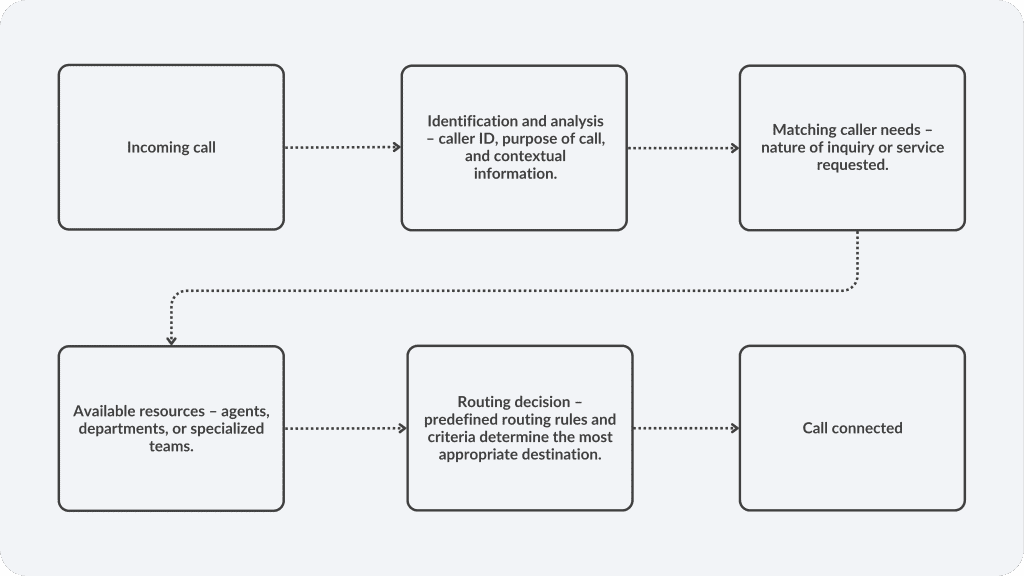Everything You Needed to Know About Call Center Call Routing
Call Center routing is the process of directing incoming calls to the most appropriate agent/destination within an organization.
It involves analyzing various factors such as caller identity, purpose of the call, agent availability, and routing preferences to ensure that each caller is connected to the right resource efficiently.
Call routing can be customized based on specific criteria, including skills-based routing, time-based routing, geographic routing, and interactive voice response (IVR).
Importance of Efficient Call Routing in Call Centers
Customer service is paramount for maintaining customer loyalty and satisfaction in today’s call center landscape.
Efficient call routing is crucial in delivering a seamless and personalized customer experience. By ensuring that callers are promptly connected to the most qualified agent or department, call centers can reduce call wait times, minimize call transfers, and increase first-call resolution rates.
This leads to improved customer satisfaction, enhanced brand reputation, and increased revenue and profitability.
Types of Call Routing
Skills-Based Routing
Skills-based routing is a call routing strategy that directs incoming calls to the most qualified agent or team based on their specific skills, expertise, and proficiencies.
It involves analyzing the nature of the customer inquiry and matching it with the agent possessing the relevant knowledge and experience to address the issue effectively.
For example, a technical support query may be routed to agents with specialized technical skills, while a billing inquiry may be directed to agents trained in financial transactions.
With skills-based routing, call centers can reduce call handling times, minimize call transfers, and increase first-call resolution rates, resulting in a more seamless and personalized customer experience and higher levels of satisfaction, loyalty, and repeat business.
Time-Based Routing
Time-based routing is a call routing strategy that directs incoming calls based on the time of day or day of the week.
It allows businesses to adjust call routing parameters dynamically to accommodate fluctuations in call volume and agent availability throughout the day.
For example, calls received during peak hours may be routed to additional agents or departments to manage high call volumes efficiently, while calls received after hours may be routed to voicemail or alternate support channels.
By routing calls intelligently during peak and off-peak hours, call centers can ensure that callers receive prompt assistance without experiencing long wait times or delays. This leads to improved customer satisfaction, reduced call abandonment rates, and enhanced overall efficiency in call-handling operations.
Geographic Routing
Geographic routing is a call routing strategy that directs incoming calls to specific locations or regions based on the caller’s location.
It allows businesses to route calls to local or regional offices, agents, or support centers, ensuring that callers are connected to resources that are geographically closest to them.
For example, a customer calling from Delhi may be routed to the nearest customer service center in North India. In contrast, a caller from Chennai may be routed to a center in South India.
By routing calls based on geographic location, businesses can offer customers a more personalized and responsive experience tailored to their needs and preferences. Additionally, geographic routing helps companies optimize resource utilization, reduce call handling times, and improve overall operational efficiency by ensuring that calls are directed to the most appropriate destination.
Interactive Voice Response (IVR) Routing
Interactive Voice Response (IVR) is an automated telephony system interacting with callers through voice and touch-tone keypad inputs.
IVR solution play a crucial role in call routing by providing callers with self-service options and guiding them through menu prompts to route their calls to the appropriate department or agent.
For example, callers may be prompted to select from a menu of options (e.g., “Press 1 for sales, Press 2 for support”) to route their calls based on their specific inquiry or request.
IVR systems offer several benefits for businesses, including providing callers with self-service options to access information or complete routine tasks without needing agent assistance.
IVR systems help streamline call-routing processes and reduce the burden on live agents.
Additionally, IVR systems can prioritize and route calls based on caller input, ensuring that urgent or high-priority calls are promptly directed to the appropriate destination.
This improves call handling efficiency, reduces wait times, and enhances overall customer satisfaction with the service experience.
Check out our blog on : How AI-Powered Conversational IVR Help Boost Customer Service in Contact Centers
Benefits of Call Center Routing
Improved Customer Experience
- Personalized routing leads to faster resolution times
- Reduction in call wait times and abandonment rates
Enhanced Agent Productivity
- Efficient call distribution maximizes agent availability.
- Increased first-call resolution rates through better call handling
Cost Savings
- Optimization of resources leads to reduced operational costs
- Avoidance of overstaffing or understaffing with dynamic routing
How Does Call Routing Work?

This diagram provides a visual representation of the sequential steps involved in the call routing process, illustrating how incoming calls are identified, analyzed, and routed to the appropriate resources within the organization.
Implementing Call Routing in Your Call Center: Step-by-Step Process
Assessment of Needs
Identifying pain points and objectives
- Conduct a thorough assessment of current call-handling processes to identify pain points, inefficiencies, and areas for improvement.
- Gather feedback from both customers and internal stakeholders to understand their expectations and challenges.
- Define specific objectives and goals for implementing call routing solutions, such as improving customer satisfaction, reducing wait times, or increasing agent productivity.
Evaluating call volume, agent capacity, and customer expectations
- Analyze historical call data to understand call volume patterns, peak hours, and seasonal fluctuations.
- Assess agent capacity and availability to determine staffing levels and resource allocation requirements.
- Consider customer expectations and preferences regarding response times, accessibility, and service quality to tailor routing strategies accordingly.
Choosing the Right Call Routing Strategy
Selecting the appropriate routing methods based on call center requirements
- Evaluate different routing methods, such as skills-based, time-based, geographic, and IVR systems, based on their suitability for addressing identified needs and objectives.
- When selecting routing methods, consider the nature of incoming calls, agent skill sets, and organizational structure.
Customizing routing parameters for optimal results
- Customize routing parameters and rules to align with specific business requirements and priorities.
- Define criteria for routing calls, such as caller ID, IVR menu selections, or geographic location, to ensure accurate and efficient call distribution.
- Implement dynamic routing strategies to adapt to changing conditions and optimize resource utilization in real-time.
Integration With Existing Systems
Seamless integration with CRM and ticketing systems
- Ensure seamless integration with existing Customer Relationship Management (CRM) systems to access customer data, history, and preferences.
- Integrate with ticketing systems to create and track support tickets, manage case resolution, and maintain a centralized record of customer interactions.
- Enable automatic data synchronization between call routing systems and CRM/ticketing platforms to ensure consistency and accuracy of information.
Ensuring compatibility with communication channels (voice, email, chat)
- Support multi-channel communication capabilities, including voice, email, chat, and social media, to accommodate diverse customer preferences.
- Ensure compatibility with omnichannel communication platforms to provide consistent and seamless customer experiences across all channels.
- Implement unified routing solutions that intelligently route interactions from various channels to the appropriate agents or departments based on predefined criteria.
Future Trends in Call Routing
AI-Powered Routing
AI-powered routing leverages predictive analytics and machine learning algorithms to analyze vast amounts of data, including historical call patterns, customer interactions, and agent performance metrics.
By identifying patterns and trends, AI can anticipate caller needs and preferences with high accuracy.
For example, AI algorithms can analyze past interactions to predict the nature of incoming calls and route them to the most suitable agent or department before the call even begins.
This proactive approach not only improves efficiency but also enhances the overall customer experience by reducing wait times and ensuring that callers are connected to the right resources quickly.
Omni-Channel Routing
Omni-channel routing enables businesses to route customer inquiries seamlessly across multiple communication channels, including voice, text, email, chat, and social media.
For example, a customer may initiate a support request via email but later prefer to continue the conversation via live chat or phone. Omni-channel routing ensures that the conversation is seamlessly transferred between channels without needing the customer to repeat information or start over.
This integrated approach to routing enhances convenience and flexibility for customers, allowing them to communicate with businesses through their preferred channels.
Intelligent Call Routing
We have implemented intelligent call-routing solutions for more than 2500 customers worldwide.
We have implemented all types of routing – skills-based, time-based, location-based, and IVR routing for all our customers.
This, combined with call queueing, call forwarding, workforce management, automated call-back systems, reporting & analytics, call recording & monitoring, and omnichannel capabilities, makes our platform a great addition to your customer experience function.
Customer expectations constantly evolve, and call routing is a pivotal strategy for enhancing customer experience and driving operational efficiency.
As explored in this article, call routing offers a myriad of benefits, including improved customer satisfaction, enhanced agent productivity, and cost savings.
Businesses can access various routing strategies and technologies to optimize their call-handling processes, from skills-based routing to AI-powered predictive analytics.
By assessing their unique needs, selecting the right routing methods, and seamlessly integrating with existing systems, organizations can unlock the full potential of call routing to meet and exceed customer expectations.
Moreover, with the rise of omni-channel communication, customers expect seamless and consistent experiences across multiple channels.
Omni-channel routing enables businesses to deliver on this expectation by routing inquiries seamlessly across voice, text, email, chat, and social media, ensuring that customers receive personalized and timely assistance regardless of the channel they choose to engage with.
As we look to the future, advancements in AI and machine learning promise to further revolutionize call routing, enabling organizations to proactively anticipate caller needs and preferences.
By leveraging predictive analytics and AI-driven insights, businesses can anticipate customer inquiries, route calls intelligently, and deliver personalized experiences that foster loyalty and drive business growth.
Call routing is not merely a technical process but a strategic imperative for businesses seeking to differentiate themselves in a competitive marketplace.
By investing in advanced routing solutions and prioritizing customer-centricity, organizations can transform their call-handling operations into a key driver of success, delivering exceptional service experiences that leave a lasting impression on customers and stakeholders alike.
